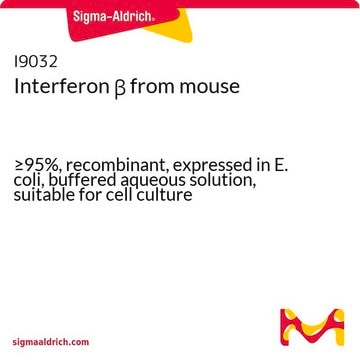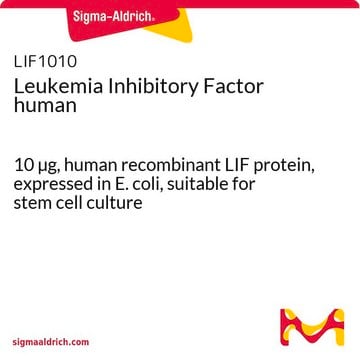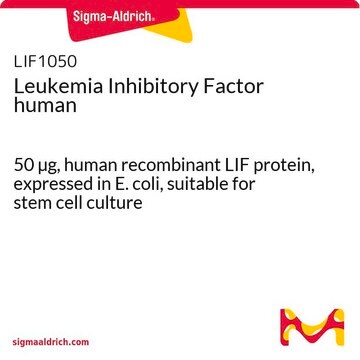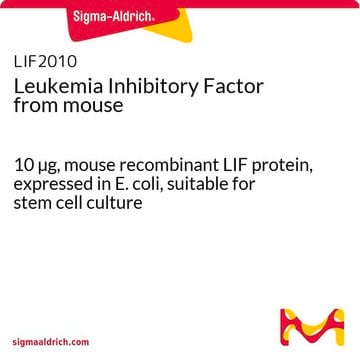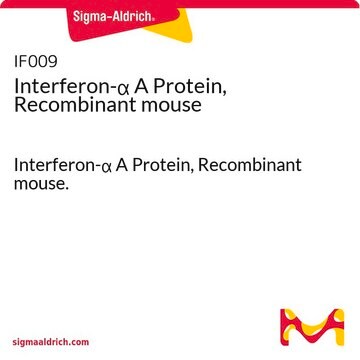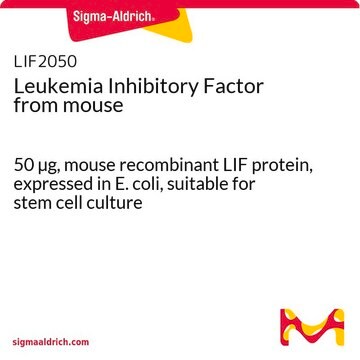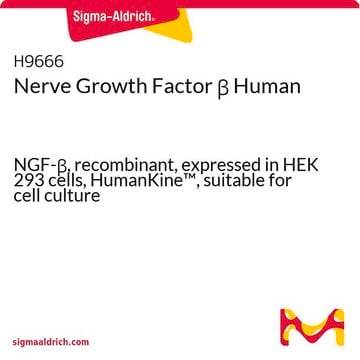추천 제품
생화학적/생리학적 작용
Leukemia Inhibitory Factor (LIF) is a pleiotropic glycoprotein originally described to inhibit the proliferation of the murine myeloid leukemic cell line M1, while inducing differentiation into macrophages. Other activities were later identified to LIF, which is known by a variety of synonyms, including DIF, D-factor, DIA, DRF, CNDF, HILDA, HSF-III, and MLPLI. Human LIF exerts its actions through a receptor comprising a 190 kDa LIF-binding α-chain (130 kDa, mouse) and a 130 kDa signal-transducing β-chain (gp130), which is shared with CNTF, OSM, L-6 and IL-11. As such, it is a member of the gp130 family of the cytokine receptor superfamily. LIF receptors have been identified on several cells, including monocytes, liver, placenta and embryonic stem cells. Natural LIF is heavily glycosylated, showing an apparent molecular weight of 32 kDa to 62 kDa, depending on the source, but absence of glycosylation appears not to affect its biological activity. A single gene encodes LIF, which is secreted as a single chain glycoprotein containing 180 amino acids for human or mouse with a conserved disulfide bond. Human and mouse LIF share 78% sequence homology. Human LIF can activate mouse cells, but mouse LIF cannot activate human cells.
물리적 형태
Solution, 0.2 μm filtered, in phosphate buffered saline containing 0.02% TWEEN® 20.
분석 메모
The proliferative activity of human LIF is measured in culture using the human leukemic cell line, TF-1.
법적 정보
TWEEN is a registered trademark of Croda International PLC
Storage Class Code
11 - Combustible Solids
WGK
WGK 3
Flash Point (°F)
Not applicable
Flash Point (°C)
Not applicable
개인 보호 장비
Eyeshields, Gloves, type N95 (US)
시험 성적서(COA)
제품의 로트/배치 번호를 입력하여 시험 성적서(COA)을 검색하십시오. 로트 및 배치 번호는 제품 라벨에 있는 ‘로트’ 또는 ‘배치’라는 용어 뒤에서 찾을 수 있습니다.
이미 열람한 고객
Pluripotent stem cell-derived models of neurological diseases reveal early transcriptional heterogeneity.
Sorek, et al.
Genome Biology, 22, 73-73 (2021)
Arno Germond et al.
Analytical chemistry, 92(22), 14915-14923 (2020-10-29)
Monitoring cell-state transition in pluripotent cells is invaluable for application and basic research. In this study, we demonstrate the pertinence of noninvasive, label-free Raman spectroscopy to monitor and characterize the cell-state transition of mouse stem cells undergoing reprogramming. Using an
A Rodríguez et al.
Theriogenology, 67(5), 1092-1095 (2007-01-11)
Leukemia inhibitory factor (LIF) is a cytokine that shows conflicting effects on in vitro produced (IVP) bovine embryos. Bovine LIF (bLIF) has been cloned and used in culture, but there is no commercially available bLIF. Thus, researchers use human LIF
Jin Gyoung Jung et al.
Biology of reproduction, 76(1), 173-182 (2006-10-13)
We recently succeeded in inducing germline transmission by transferring chicken testicular cells into heterologous testes. This study was designed subsequently to identify pluripotent cells in the testicular cells, which would induce the germline transmission. Testicular cells retrieved from juvenile (4-wk-old)
Shigeo Saito et al.
Methods in molecular biology (Clifton, N.J.), 329, 59-79 (2006-07-19)
We describe here the isolation and maintenance of pluripotent embryonic stem (ES) cells from equine blastocysts that have been frozen and thawed. Equine ES cells appear to maintain a normal diploid karyotype in culture. These cells express markers that are
문서
Leukemia Inhibitory Factor (LIF) is a stem cell growth factor used for the in vitro culture of pluripotent mouse embryonic stem cells (ES cells).
Naive pluripotent stem cells cultured in vitro using specialized media and inhibitors mimic "ground-state" cells from blastocysts.
자사의 과학자팀은 생명 과학, 재료 과학, 화학 합성, 크로마토그래피, 분석 및 기타 많은 영역을 포함한 모든 과학 분야에 경험이 있습니다..
고객지원팀으로 연락바랍니다.